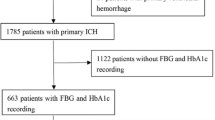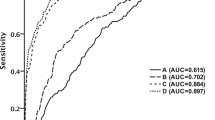Abstract
Background
We have previously reported the association of hyperglycemia and mortality after ischemic stroke. This study attempts to answer the hypothesis, if hyperglycemia at arrival, is associated with early mortality and functional outcome in patients with acute non-traumatic intracerebral hemorrhage (ICH).
Methods
The study cohort consisted of 237 patients who presented to the ED with ICH and had blood glucose measured on ED presentation. The presence of hyperglycemia on presentation was correlated with outcome measures including volume of hematoma, intraventricular extension of hematoma (IVE), stroke severity, functional outcome at discharge, and date of death.
Results
Of the cohort of 237 patients, a total of 47 patients had prior history of Diabetes Mellitus (DM). Median blood glucose at presentation was 140 mg/dl (Inter-quartile range 112–181 mg/dl). DM patients had higher glucose levels on arrival (median 202 mg/dl for DM vs. 132.5 mg/dl for non-DM, P < 0.0001). Higher blood glucose at ED arrival was associated with early mortality in both non-diabetics and diabetics (P < 0.0001). Higher blood glucose was associated with poor functional outcome in non-DM patients (P < 0.0001) but not in DM patients (P = 0.268). In the logistic regression model, after adjustment for stroke severity, hematoma volume, and IVE of hemorrhage, higher initial blood glucose was a significant predictor of death (P = 0.0031); as well as bad outcome in non-DM patients (P = 0.004).
Conclusions
Hyperglycemia on presentation in non-diabetic patients is an independent predictor of early mortality and worse functional outcome in patients with intracerebral hemorrhage.

Similar content being viewed by others
References
Lloyd-Jones D, Adams R, Carnethon M, et al. Heart Disease and Stroke Statistics–2009 Update. A Report From the American Heart Association Statistics Committee and Stroke Statistics Subcommittee. Circulation; 2008.
Douglas MA, Haerer AF. Long-term prognosis of hypertensive intracerebral hemorrhage. Stroke. 1982;13:488–91.
Helweg-Larsen S, Sommer W, Strange P, Lester J, Boysen G. Prognosis for patients treated conservatively for spontaneous intracerebral hematomas. Stroke. 1984;15:1045–8.
Bamford J, Sandercock P, Dennis M, Burn J, Warlow C. A prospective study of acute cerebrovascular disease in the community: the Oxfordshire Community Stroke Project—1981–86. 2. Incidence, case fatality rates and overall outcome at one year of cerebral infarction, primary intracerebral and subarachnoid haemorrhage. J Neurol Neurosurg Psychiatry. 1990;53:16–22.
Kojima S, Omura T, Wakamatsu W, et al. Prognosis and disability of stroke patients after 5 years in Akita, Japan. Stroke. 1990;21:72–7.
Anderson CS, Chakera TM, Stewart-Wynne EG, Jamrozik KD. Spectrum of primary intracerebral haemorrhage in Perth, Western Australia, 1989–90: incidence and outcome. J Neurol Neurosurg Psychiatry. 1994;57:936–40.
Qureshi AI, Tuhrim S, Broderick JP, Batjer HH, Hondo H, Hanley DF. Spontaneous intracerebral hemorrhage. N Engl J Med. 2001;344:1450–60.
Torbey MT. Intracerebral hemorrhage: what’s next? Stroke. 2009;40:1539–40.
Broderick J, Connolly S, Feldmann E, et al. Guidelines for the management of spontaneous intracerebral hemorrhage in adults: 2007 update: a guideline from the American Heart Association/American Stroke Association Stroke Council, High Blood Pressure Research Council, and the Quality of Care and Outcomes in Research Interdisciplinary Working Group. Stroke. 2007;38:2001–23.
Steiner T, Kaste M, Forsting M, et al. Recommendations for the management of intracranial haemorrhage—part I: spontaneous intracerebral haemorrhage. The European Stroke Initiative Writing Committee and the Writing Committee for the EUSI Executive Committee. Cerebrovasc Dis. 2006;22:294–316.
Arboix A, Manzano C, Garcia-Eroles L, et al. Determinants of early outcome in spontaneous lobar cerebral hemorrhage. Acta Neurol Scand. 2006;114:187–92.
Seo W, Oh H. Acute physiologic predictors of mortality and functional and cognitive recovery in hemorrhagic stroke: 1-, 3-, and 6-month assessments. J Stroke Cerebrovasc Dis. 2007;16:57–63.
Hanggi D, Steiger HJ. Spontaneous intracerebral haemorrhage in adults: a literature overview. Acta Neurochir (Wien). 2008;150:371–9. (discussion 9).
Broderick JP, Brott TG, Duldner JE, Tomsick T, Huster G. Volume of intracerebral hemorrhage: a powerful and easy-to-use predictor of 30-day mortality. Stroke. 1993;24:987–93.
Lindsberg PJ, Roine RO. Hyperglycemia in acute stroke. Stroke. 2004;35:363–4.
Christensen H, Boysen G. Blood glucose increases early after stroke onset: a study on serial measurements of blood glucose in acute stroke. Eur J Neurol. 2002;9:297–301.
Weir CJ, Murray GD, Dyker AG, Lees KR. Is hyperglycaemia an independent predictor of poor outcome after acute stroke? Results of a long-term follow up study. BMJ. 1997;314:1303–6.
Stead LG, Gilmore RM, Bellolio MF, et al. Hyperglycemia as an independent predictor of worse outcome in non-diabetic patients presenting with acute ischemic stroke. Neurocrit Care. 2008;10:181–6.
Bruno A, Biller J, Adams HP Jr, et al. Acute blood glucose level and outcome from ischemic stroke. Trial of ORG 10172 in acute stroke treatment (TOAST) investigators. Neurology. 1999;52:280–4.
Demchuk AM, Morgenstern LB, Krieger DW, et al. Serum glucose level and diabetes predict tissue plasminogen activator-related intracerebral hemorrhage in acute ischemic stroke. Stroke. 1999;30:34–9.
Lanzino G, Kassell NF, Germanson T, Truskowski L, Alves W. Plasma glucose levels and outcome after aneurysmal subarachnoid hemorrhage. J Neurosurg. 1993;79:885–91.
Chmielewska B, Hasiec T, Belniak-Legiec E. [The concentration of glucose, glycosylated hemoglobin and fructosamine in blood of patients with cerebral hemorrhage in the acute stage of the disease]. Ann Univ Mariae Curie Sklodowska [Med]. 1995;50:123–30.
Kothari RU, Brott T, Broderick JP, et al. The ABCs of measuring intracerebral hemorrhage volumes. Stroke. 1996;27:1304–5.
Williams LS, Yilmaz EY, Lopez-Yunez AM. Retrospective assessment of initial stroke severity with the NIH Stroke Scale. Stroke. 2000;31:858–62.
Cheung CM, Tsoi TH, Hon SF, et al. Using the National Institutes of Health Stroke Scale (NIHSS) to predict the mortality and outcome of patients with intracerebral haemorrhage. Hong Kong Med J. 2008;14:367–70.
Gilmore RM, Stead LG. The role of hyperglycemia in acute ischemic stroke. Neurocrit Care. 2006;5:153–8.
Song EC, Chu K, Jeong SW, et al. Hyperglycemia exacerbates brain edema and perihematomal cell death after intracerebral hemorrhage. Stroke. 2003;34:2215–20.
Lu A, Tang Y, Ran R, Ardizzone TL, Wagner KR, Sharp FR. Brain genomics of intracerebral hemorrhage. J Cereb Blood Flow Metab. 2006;26:230–52.
Mechanick JI. Metabolic mechanisms of stress hyperglycemia. JPEN J Parenter Enteral Nutr. 2006;30:157–63.
Araki N, Greenberg JH, Sladky JT, Uematsu D, Karp A, Reivich M. The effect of hyperglycemia on intracellular calcium in stroke. J Cereb Blood Flow Metab. 1992;12:469–76.
Kimura K, Iguchi Y, Inoue T, et al. Hyperglycemia independently increases the risk of early death in acute spontaneous intracerebral hemorrhage. J Neurol Sci. 2007;255:90–4.
Fogelholm R, Murros K, Rissanen A, Avikainen S. Admission blood glucose and short term survival in primary intracerebral haemorrhage: a population based study. J Neurol Neurosurg Psychiatry. 2005;76:349–53.
Tetri S, Juvela S, Saloheimo P, Pyhtinen J, Hillbom M. Hypertension and diabetes as predictors of early death after spontaneous intracerebral hemorrhage. J Neurosurg. 2008;110:411–7.
Capes SE, Hunt D, Malmberg K, Pathak P, Gerstein HC. Stress hyperglycemia and prognosis of stroke in nondiabetic and diabetic patients: a systematic overview. Stroke. 2001;32:2426–32.
Passero S, Ciacci G, Ulivelli M. The influence of diabetes and hyperglycemia on clinical course after intracerebral hemorrhage. Neurology. 2003;61:1351–6.
Godoy DA, Pinero GR, Svampa S, Papa F, Di Napoli M. Hyperglycemia and short-term outcome in patients with spontaneous intracerebral hemorrhage. Neurocrit Care. 2008;9:217–29.
Gray CS, Hildreth AJ, Sandercock PA, et al. Glucose-potassium-insulin infusions in the management of post-stroke hyperglycaemia: the UK Glucose Insulin in Stroke Trial (GIST-UK). Lancet Neurol. 2007;6:397–406.
Ho CL, Ang CB, Lee KK, Ng IH. Effects of glycaemic control on cerebral neurochemistry in primary intracerebral haemorrhage. J Clin Neurosci. 2008;15:428–33.
Yong M, Kaste M. Dynamic of hyperglycemia as a predictor of stroke outcome in the ECASS-II trial. Stroke. 2008;39:2749–55.
Acknowledgements
Dr. Stead is supported through a Mayo Foundation Emergency Medicine Research Career Development Award. This publication was made possible by Grant Number 1 UL1 RR024150 from the National Center for Research Resources (NCRR), a component of the National Institutes of Health (NIH), and the NIH Roadmap for Medical Research. Its contents are solely the responsibility of the authors and do not necessarily represent the official view of NCRR or NIH. Information on NCRR is available at http://www.ncrr.nih.gov/. Information on Reengineering the Clinical Research Enterprise can be obtained from http://nihroadmap.nih.gov.
Author information
Authors and Affiliations
Corresponding author
Rights and permissions
About this article
Cite this article
Stead, L.G., Jain, A., Bellolio, M.F. et al. Emergency Department Hyperglycemia as a Predictor of Early Mortality and Worse Functional Outcome after Intracerebral Hemorrhage. Neurocrit Care 13, 67–74 (2010). https://doi.org/10.1007/s12028-010-9355-0
Published:
Issue Date:
DOI: https://doi.org/10.1007/s12028-010-9355-0




